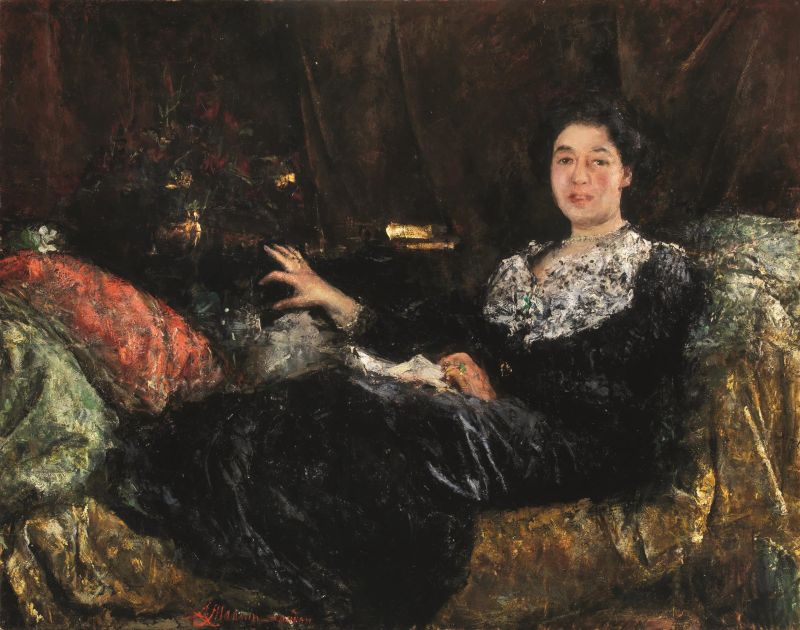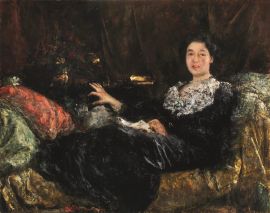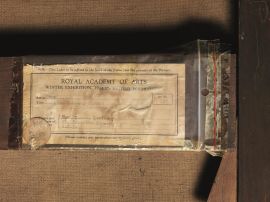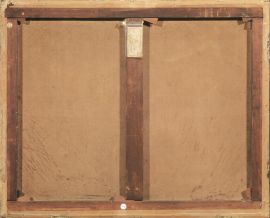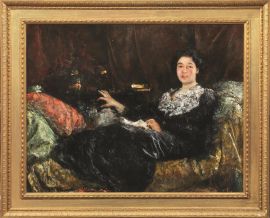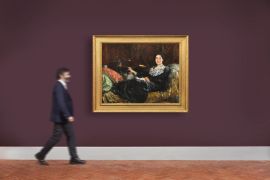Antonio Mancini (Roma, 1852 - Roma, 1930)
Antonio Mancini
Antonio Mancini
(Roma 1852 - Roma 1930)
RITRATTO DI MATHILDE HIRSCH
olio su tela, cm 101x126
firmato e iscritto "London" in basso a sinistra
retro: sul telaio cartiglio della mostra alla Royal Academy of Arts di Londra del 1956-1957
MRS LEOPOLD HIRSCH
oil on canvas, 39" 3/4 x 49" 1/2
signed and inscribed "London" lower left
on the reverse: on the stretcher label of the exhibition at the Royal Academy of Arts in London, 1956-1957
Provenienza
Mrs Leopold Hirsch, Londra
Mrs Thomas Lowinsky
Collezione Margaret Wilson Llangammarch, Breconshire, Inghilterra
Collezione J.S. Clarke (in deposito al Bristol City Museum Art Gallery, 1958-1983)
Collezione Edward Cohen, Londra
Collezione privata, Milano
Esposizioni
Italian Exhibition, Earl's Court, Londra, 1904
British Portraits, Royal Academy of Arts, Londra, 1956-1957
Trafalgar Galleries at the Royal Academy III, Londra, 1983
Bibliografia
Italian Exhibition, Earl's Court, London 1904, p. 56
E. Giannelli, Artisti napoletani viventi. Pittori, scultori, incisori, architetti, Napoli 1916, p. 308
A. Schettini, Mancini, Napoli 1953, p. 240
British Portraits, Catalogue 3 - second edition, winter exhibition (Royal Academy of Arts, Londra, 1956-1957), London 1956, p. 149, n. 483 (con datazione erronea 1906 circa)
Bristol Art Gallery Annual Report, 1958
D. Cecchi, Antonio Mancini, Torino 1966, pp. 184, 193-194, 325, ripr. tav. 28
D. Cecchi, Denunciò la propria famiglia l'immortalatore degli "Scugnizzi". Scritti inediti di Antonio Mancini, "o pittore pazzo", in "Giornale d'Italia", 28-29 gennaio 1969, p. 3
Don Riccardo, Artecatalogo dell’Ottocento. “Vesuvio” dei pittori napoletani, vol. II, Roma 1973, p. 289
Trafalgar Galleries at the Royal Academy III, London 1983, pp. 98-99, n. 38 ripr.
Phillips Son and Neale, 18 aprile 1983, n. 173 (da Witt Library)
Le opere pittoriche vendute in Italia e all'estero, a cura de "Il Mercato Dell'Arte" - Prezzi e mercato 2, Como 1984, p. 98 ripr.
E. Kilmurray, R. Ormond, John Singer Sargent. The later portraits. Complete Paintings, vol. III, New Haven and London 2003, p. 74
W. Hiesinger in Antonio Mancini Nineteenth-Century Italian Master Celebrating the Vance N. Jordan Collection at the Philadelphia Museum of Art, Philadelphia Museum of Art, 20 ottobre 2007 - 20 gennaio 2008, catalogo a cura di U.W. Hiesinger, New Haven 2007
M. Ursino, Ritratti Eccellenti nella pittura di grandi maestri dell'Ottocento e del Novecento, presentazione di M. Calvesi, Roma 2007, p. 54
M. Carrera, Antonio Mancini in Inghilterra. Il rapporto con John Singer Sargent in “Storia dell’arte”, 133, settembre-dicembre 2012, pp. 153-180: 165, ripr. fig. 15
C. Virno, Antonio Mancini. Catalogo ragionato dell'opera, Roma 2019, vol. I, pp. 321-322 n. 530
Nel maggio del 1902, Antonio Mancini partecipa alla prestigiosa esposizione alla Royal Academy di Londra debuttando così ufficialmente tra i ritrattisti contemporanei attivi in terra inglese. Arrivato in Inghilterra l’anno precedente grazie al rapporto di consolidata amicizia con il collega americano John Singer Sargent, il suo impegno nei mesi vissuti a Londra si concentra proprio sulla ritrattistica di commissione, tematica principale della sua ricchissima produzione.
Il dipinto esposto alla Royal Academy con il generico titolo Portrait of a lady, è identificabile con il Ritratto di Mary Hunter, nota collezionista di arte contemporanea, amica di Sargent e principale committente di Mancini nel periodo londinese. La Hunter, già effigiata da Sargent nel 1898 in un dipinto a figura intera custodito alla Tate Gallery di Londra, viene raffigurata da Mancini in abito nero su sfondo scuro in un ambiente della casa di famiglia di Selaby, nel Darlington, luogo in cui l’artista romano ritrae anche il marito e la figlia. Alla sua sinistra c’è un mobile su cui la signora sembra cercare un appoggio con la mano mentre è comodamente adagiata su un divanetto di stoffa gialla che illumina la scena.
Il quadro sembra essere speculare al nostro, realizzato pochi mesi dopo e raffigurante la moglie di Leopold Hirsch, Mathilde, seduta su un sofà dai toni giallo dorato, tra morbidi cuscini colorati che le coprono i piedi. Tiene con una mano un libro aperto, le cui pagine bianche, assieme al tessuto che le ricopre il decolté, diventano una meravigliosa fonte di luce, mentre l’altra è appoggiata a un tavolino alla sua destra. In entrambi i ritratti si nota la generosa pennellata materica, tipica della produzione di Mancini di questo periodo, che tanto colpisce la critica intervenuta all’esposizione della Royal Academy.
La signora, elegantemente vestita con un abito nero che acquista volume grazie alla pastosità della pennellata, guarda con un’espressione curiosa, difficilmente decifrabile, il pittore che la ritrae nella sua dimora, attorniata da vari oggetti, sullo sfondo di un tendone scuro che impedisce alla luce di filtrare e crea un effetto di quinta teatrale. Per un certo periodo, le giornate di posa necessarie per eseguire questo dipinto si sovrappongono a quelle richieste da Sargent impegnato a portare a termine un altro ritratto di Mathilde esposto, proprio nel 1902, alla Royal Academy.
Mentre il quadro di Sargent è impostato con la figura in piedi, seguendo un gusto di tradizione e di ufficialità con dei chiari rimandi, nell’abito rosa e nel pizzo bianco, al Ritratto di Filippo IV di Spagna di Velasquez - allontanandosi quindi dalla scioltezza della posa tipica della sua felice produzione -, in quello di Mancini il contesto è più informale e vicino alcuni insegnamenti attinti proprio dalla ritrattistica dell’amico. Quel gesto della mano, ad esempio, così particolare e anomalo nelle figure effigiate dal pittore romano, si trova frequentemente nelle opere di Sargent già dal decennio precedente. Basti pensare al Ritratto di Mrs Hugh Hammersley del 1892, o a quello delle sorelle Wyndham, del 1899, entrambi al Metropolitan Museum di New York. Nel primo caso la protagonista, seduta senza appoggiare il busto posto di fronte allo spettatore, ruota il braccio sinistro per appoggiarlo allo schienale del divanetto, nel secondo la mano della giovane collocata tra le altre due effigiate, sembra voglia allungarsi sinuosamente fino oltre la tela, incrociando quella della sorella alle sue spalle.
All’epoca dei due ritratti, Frances Mathilde Seligmann, sposatasi nel 1890 con il facoltoso banchiere londinese Leopold Hirsch e apprezzato collezionista di arte antica e contemporanea, ha trentun anni. Si spegnerà nel 1921, undici anni prima del marito, scomparso a 75 anni. L’11 maggio 1934 la raccolta d’arte dei coniugi Hirsch viene battuta all’asta nella sede londinese di Christie, Manson & Woods, accompagnata dal catalogo dal titolo The collection of important pictures drawings and engravings of Leopold Hirsch. Il dipinto di Mancini, però, rimane in famiglia, nella collezione della figlia Ruth, moglie del pittore Thomas Lowinsky.
La gestazione dell’opera manciniana ci viene in parte svelata da Dario Cecchi nella monografia sul pittore del 1966, dove, a pagina 184, leggiamo: “In data 24 febbraio 1902 [Mancini] aveva ricevuto una breve letterina dal ricco e notissimo Leopold Hirsch con la quale gli si richiedeva quale cifra il pittore avrebbe richiesto per fare il ritratto alla di lui moglie Mathilde”. Due mesi dopo Mancini sta ancora lavorando al dipinto quando ottiene, grazie a Lady Hunter, l’incarico di eseguire al più presto un ritratto a Lord Currie, ambasciatore inglese a Roma presso il re d’Italia. Ciò avrebbe significato una repentina partenza per l’Italia con la necessità di rientrare solertemente a Londra per finire, entro i termini di consegna pattuiti, il ritratto di Mathilde.
Mancini entra in agitazione, chiede quindi consiglio a Sargent che minimizza il problema. Si rivolge allora al marchese Giorgio Capranica del Grillo, suo mecenate e protettore, scrivendogli a Roma: “io debbo qui a Londra finire il ritratto di Madama Hirsch a maggio, di cui ho ricevuto cento sterline in anticipo…” (Cecchi, p. 191). Nel frattempo vive con forte frustrazione l’inaugurazione alla Royal Academy a cui non vuole presenziare perché amareggiato dall’accettazione di un suo solo dipinto, per altro mal posizionato, su quattro presentati. Inoltre è deluso dal comportamento di Sargent, molto ben introdotto alla Royal Academy, ma poco disponibile ad appianare le ansie dell’amico, in parte immotivate. La sua risaputa instabilità psichica non gli consente di godere degli ottimi riscontri ottenuti dal quadro esposto, anzi, peggiora a causa dei frequenti snervanti rinvii da parte di Mathilde Hirsch per posare al ritratto e dalle inopportune sollecitazioni del marito che lamenta lentezza nella realizzazione del quadro. Queste frizioni con i signori Hirsch culminano in una lettera di risposta di Mancini a Mr. Leopold nella quale emerge chiaramente che il problema dell’avanzamento rallentato del lavoro, sia imputabile a “l’ennui de Madame à poser”. Proprio per evitare di arrecare ulteriore disturbo alla signora, Mancini propone al marito di farsi restituire la tela incompleta e, in cambio delle 100 sterline già riscosse, di dipingere “une peinture agreable pour le même prix” (Cecchi, p. 194, nota 3). Motivando l’impossibilità di scegliere un supporto di dimensioni maggiori “parce que la grille que je mets devant le model me donne cet grandeur mathematique” - Hirsch ha espresso perplessità riguardo la superficie pittorica? – Mancini ci conferma, anche per questo dipinto, l’utilizzo della graticola, una coppia di telai quadrettati a spago, posti davanti al modello e alla tela per garantire l'esattezza delle proporzioni nell'impianto prospettico. Il quadrettato, si sa, è spesso volutamente lasciato a vista nelle opere manciniane e qui si nota chiaramente in particolare nella zona del cuscino rosa.
Il 30 aprile una comunicazione del segretario di Hirsch pone fine all’impasse. Mancini viene pregato di riprendere il lavoro tanto bene iniziato e finalmente riesce a portarlo a temine con soddisfazione dei committenti che il 24 giugno gli inviano un bigliettino di congratulazioni su cui il pittore annota: “Ricevetti il resto di 60 sterline alle 160 ricevute già” (M. Carrera, Antonio Mancini in Inghilterra. Il rapporto con John Singer Sargent, “Storia dell’Arte”, 133, 2012, n. 33, CAM Editrice, Roma, p. 179, nota 86). Terminato il dipinto, Mancini lascia Londra e torna a Roma da Capranica che ha seguito, seppur da lontano, tutta la vicenda. L’abilità di eccelso pittore gli ha permesso di concludere egregiamente il ritratto di Mathilde senza lasciare trasparire la sofferenza patita nel periodo di realizzazione.
In May 1902, Antonio Mancini participated in the prestigious exhibition at the Royal Academy in London, making his official debut among the portrait painters working in England. He had arrived there the previous year thanks to his friendship with the American artist John Singer Sargent. During his stay in London he devoted himself to painting commissioned portraits – the main part of his large oeuvre.
The painting he showed at the Royal Academy with the generic title, Portrait of a Lady, is actually the Portrait of Mary Hunter, a renowned collector of contemporary art, friend of Sargent and Mancini’s main client during his London period. In 1898, Sargent had painted a full-figure portrait of Mrs Charles Hunter which is in the Tate Gallery in London. Mancini portrayed her in a black dress against a dark background in one of the rooms of Selaby Hall, Darlington, where the artist also painted portraits of her husband and daughter. Her left hand touches on a table as she reclines comfortably on a sofa draped in yellow cloth that illuminates the scene.
The picture seems almost a mirror image of our painting that was executed just a few months later. Mancini portrayed Leopold Hirsch’s wife, Mathilde, reclining on a golden yellow sofa with coloured cushions covering her feet. The white pages of the open book she is holding in her left hand and the fabric covering her décolleté become a wonderful source of light as she rests her right hand on a little table. Both portraits are characterized by the thick brushstrokes Mancini used during that period and which impressed the critics attending the exhibition at he Royal Academy.
The lady, elegantly attired in black acquires volume thanks to the soft, pasty brushstrokes; her expression is curious and quite difficult to decipher. She sat for the artist in her home, surrounded by various objects, and against a dark curtain that prevents light from filtering through creating a theatrical backdrop. For a while the sittings for this portrait overlapped with Sargent’s requests since he was busy completing another picture of Mathilde that was also exhibited at the Royal Academy in 1902.
The portrait by Sargent is a full-length standing figure, following a traditional and stately style with clear references, in the pink dress and white lace, to the Portrait of Philip IV of Spain by Velázquez – and therefore, distant from the graceful, smooth poses of his successful portraits. In the Mancini portrait the context is more informal and reflects some of the lessons taken from his friend’s style. For example, the position of the hand that is unusual in Mancini’s paintings was already frequent in Sargent’s works a decade earlier. It is sufficient to mention the portraits of Mrs Hugh Hammersley (1892), or The Wyndham Sisters: Lady Elcho, Mrs. Adeane, and Mrs. Tennant (1899), both in the Metropolitan Museum of Art in New York. In the first, the subject is sitting upright, facing the viewer, turns and extends her left arm so that it leans against the backrest of the sofa; in the second the arm of the girl in the centre seems to want to reach beyond the canvas.
Frances Mathilde Seligmann, who married the rich London banker and renowned art collector Leopold Hirsch in 1890, was thirty-one years old when the portraits were painted. She died in 1921, predeceasing her husband, who lived to be seventy-five, by eleven years. The Hirsch’s art collection was sold by Christie, Manson & Woods of London on 11 May 1934; the sale catalogue was entitled The Collection of Important Pictures Drawings and Engravings of Leopold Hirsch. The portrait by Mancini, however, remained with the family, in the collection of their daughter Ruth who was married to the painter Thomas Lowinsky.
Dario Cecchi partially told the story of Mancini’s portrait in his 1966 monograph on the artist. On page 184: “In data 24 febbraio 1902 [Mancini] aveva ricevuto una breve letterina dal ricco e notissimo Leopold Hirsch con la quale gli si richiedeva quale cifra il pittore avrebbe richiesto per fare il ritratto alla di lui moglie Mathilde”. Two months later, Mancini was still working on the painting when, thanks to Lady Hunter, he received the commission to do a portrait of Lord Currie, the English ambassador to Rome, as quickly as possible. That would have meant having to leave immediately for Italy, and then return to London as soon as possible to finish Mathilde’s portrait by the agreed-upon deadline.
Mancini became agitated and asked Sargent for advice, but he downplayed the problem. Then he wrote to his patron and protector in Rome, Marchese Giorgio Capranica del Grillo: “io debbo qui a Londra finire il ritratto di Madama Hirsch a maggio, di cui ho ricevuto cento sterline in anticipo…” (Cecchi, p. 191). In the meantime, he was very frustrated by the opening of the Royal Academy exhibition; he did not want to attend because they only showed one of the four paintings he submitted and in was poorly positioned as well. He was also disappointed by Sargent’s behaviour. The man was well placed at the Royal Academy, but unwilling to soothe his friend’s, partly unmotivated, anxieties. Mancini’s psychological instability was common knowledge and it prevented him from enjoying the excellent reviews of his painting. In fact, it worsened because of Mathilde’s frequent and unnerving postponements of her sittings and her husband’s inappropriate and stressful complaints about the artist’s slowness in completing the portrait. The ongoing friction with the Hirsches culminated in a letter Mancini wrote to Leopold clearly revealing that the delays were due to “l’ennui de Madame à poser”. In order to avoid further bothering the lady, Mancini suggested that Mr. Hirsch return the unfinished portrait and, in exchange for the hundred pounds he had already received, he painted “une peinture agréable pour le même prix” (Cecchi, p. 194, note 3). He explained the impossibility of choosing a bigger canvas, “parce que la grille que je mets devant le model [sic] me donne cet grandeur mathematique [sic]” - Was Hirsch expressing his perplexity about the size? – Mancini confirmed that in this painting, like others, he used a grid – two frames squared with string that he placed in front of the model and in front of the canvas to guarantee the exact proportions of the composition. Indeed, Mancini often deliberately left his grids visible and here we can see it quite clearly on the pink cushion.
A letter from Hirsch’s secretary dated 30 April put an end to the impasse. Mancini was asked to resume the painting that had started so well and he finally completed it to the satisfaction of his clients. On 24 June they sent him a note of congratulations on which the artist noted: “Ricevetti il resto di 60 sterline alle 160 ricevute già” (M. Carrera, “Antonio Mancini in Inghilterra. Il rapporto con John Singer Sargent”, Storia dell’Arte, 133, 2012, n. 33, CAM Editrice, Rome, p. 179, note 86). With the painting completed, Mancini left London and returned to Rome, to Giorgio Capranica who had followed the whole story, albeit from a distance. The artist’s outstanding skills allowed him to brilliantly finish Mathilde’s portrait without revealing how much he had suffered while painting it.

